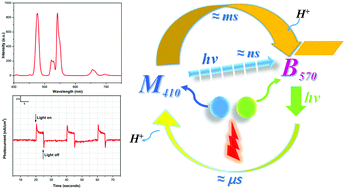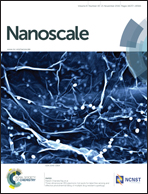Controllable stationary photocurrents generated from a bacteriorhodopsin/upconversion nanoparticle-based bionanosystem under NIR illumination†
Abstract
In the past few decades, tremendous effort has been dedicated to develop bacteriorhodopsin (bR)-based photo-electronic devices for generating a stationary photocurrent and further for use as a component of artificial retinas in constant illumination sensing. However, an IR-triggered stationary photocurrent with controllable amplitudes has never been realized to date. Herein, NaYF4:Yb,Er and NaYF4:Yb,Tm upconversion nanoparticles (UCNPs) with green and blue emissions, respectively, were synthesized and further incorporated with bR to build a bionanosystem. Under 980 nm NIR irradiation the UCNPs function as internal green and blue light sources to initiate the photocycle and speed up the transition of bR from M410 to the ground state, consequently accelerating the bR photocycle for the generation of a stationary photocurrent. Moreover, the photocurrent profile could be tailored by changing the blue/green emission intensity ratio. The mechanism is analysed to explore the scientific insights. The system consisting of controllable blue and green light sources may not only hold great promise to construct new types of bR-based optical devices, but also offers a useful setup to investigate the fundamental science underlying the bR photoresponse.


 Please wait while we load your content...
Please wait while we load your content...